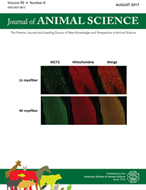-
Views
-
Cite
Cite
Y. Wang, D. Greer, T. A. McAllister, Effects of moisture, roller setting, and saponin-based surfactant on barley processing, ruminal degradation of barley, and growth performance by feedlot steers, Journal of Animal Science, Volume 81, Issue 9, September 2003, Pages 2145–2154, https://doi.org/10.2527/2003.8192145x
Close - Share Icon Share
ABSTRACT
Two experiments were conducted to study the effects of six processing techniques for barley grain in a 3 × 2 factorial arrangement of grain conditions and roller settings on ruminal degradation of the grain (Exp. 1) and on growth performance by 138 feedlot steers (n = 23 per treatment; Exp. 2). Dry barley (11% moisture, D barley), barley tempered to 20% moisture (M barley), and barley tempered with 60 mL/t of surfactant-based tempering agent (GrainPrep, Agrichem, Inc., Anoka, MN; MS barley), were each rolled at two roller settings selected from preliminary tests. The settings selected for the study were RD, the roller position that had yielded optimally processed D barley, and RMS, the setting that had yielded optimally processed MS barley. Setting RMS was tighter than RD. Barley rolled at the RMS setting was more extensively processed (i.e., had a lower [P < 0.001] processing index, PI), had lighter (P < 0.001) volume weight, thinner (P < 0.001) kernels, and fewer (P < 0.001) whole kernels compared with setting RD. Tempering did not affect (P > 0.05) PI, percentage of whole kernels, or kernel thickness at either roller setting. The processing characteristics of tempered barley were unaffected (P > 0.05) by surfactant. The extent of in situ DM disappearance (ISDMD) was higher (P < 0.01) in grain rolled at setting RMS compared with RD. At both roller settings, tempering reduced (P < 0.05) ISDMD between 4 and 24 h of ruminal incubation. Steers fed RMS-rolled barley had lower (P < 0.001) DMI, slightly lower (P = 0.084) ADG, but increased (P < 0.05) gain:feed (G:F) compared with steers fed RD-rolled barley. Tempering did not affect (P > 0.05) ADG, DMI, or G:F during backgrounding, but improved (P < 0.01) these variables during finishing. Surfactant improved (P < 0.05) G:F but not DMI or ADG. The improvement in G:F was most pronounced when setting RMS was used. The optimal PI values calculated from performance data were numerically greater for the backgrounding diet than for the finishing diet. Steers fed M or MS barley had heavier (P < 0.01) hot carcasses and thicker (P < 0.05) fat cover but lower (P < 0.05) dressing percentages than steers fed D. When the feed barley was rolled at setting RMS, steers fed MS barley produced heavier (P < 0.05) carcasses than those fed M. Tempering with or without surfactant increased performance by feedlot steers compared with not tempering. Diet composition and degree of barley processing mediated this effect.





